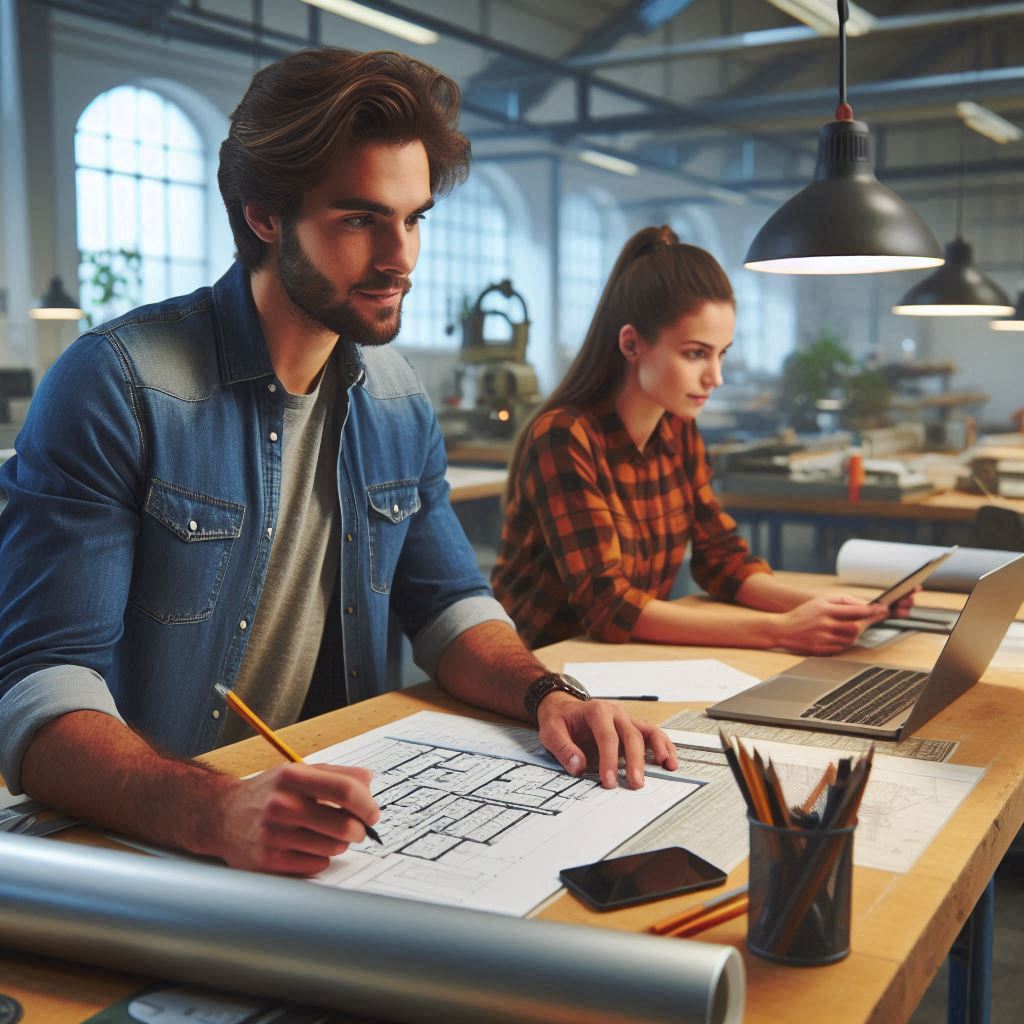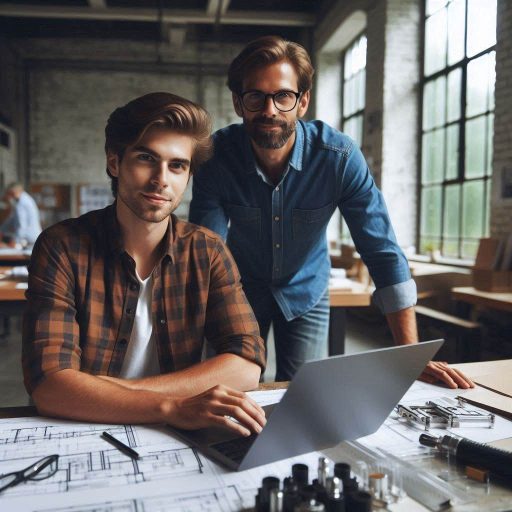Introduction
Industrial design is a field that blends art, engineering, and functionality.
It focuses on creating and improving products used in daily life.
From the sleek smartphone you carry to the ergonomic chair at your desk, industrial design shapes the tools and objects that enhance our routines.
This field ensures products are not only aesthetically pleasing but also functional and user-friendly.
Industrial designers play a crucial role in this process.
They transform ideas into tangible objects that meet both aesthetic and practical needs.
Their work starts with understanding user needs and ends with the final product’s design.
This process involves sketching, modeling, and testing ideas to ensure they work effectively in real-world situations.
An industrial designer’s day often begins with a review of ongoing projects.
They might start by analyzing feedback from previous designs or discussing improvements with their team.
This feedback helps refine products and address any issues that arose during testing.
Designers then move on to brainstorming sessions where they generate new ideas and concepts.
Education and Training Required to Become an Industrial Designer
The Typical Educational Background Needed
To embark on a career as an industrial designer, a solid educational foundation is essential.
Most industrial designers start with a degree in industrial design, product design, or a related field.
These programs typically span four years and provide comprehensive knowledge of design principles, materials, and manufacturing processes.
Industrial design degrees offer coursework in 3D modeling, ergonomics, and user experience.
Students learn to balance aesthetics with functionality.
Hands-on projects are crucial, allowing students to apply theoretical knowledge in practical scenarios.
Internships during the program offer valuable industry experience and networking opportunities.
Any Additional Certifications or Skills That May Be Beneficial
In addition to a degree, pursuing certifications can enhance career prospects.
Certifications like Certified Industrial Designer (CID) can validate your expertise and commitment to the field.
Such certifications often require passing exams and meeting experience requirements.
They demonstrate a high level of proficiency and dedication.
Skills in specific software tools are also vital.
Proficiency in CAD (Computer-Aided Design) software is a must.
Tools like SolidWorks, Rhino, and Adobe Creative Suite are commonly used in the industry.
Mastering these tools allows designers to create precise models and prototypes.
Staying updated with industry trends is another key aspect.
Continuous learning through workshops and seminars can be beneficial.
Emerging technologies, such as 3D printing and sustainable materials, shape the future of industrial design.
Adapting to these changes can set you apart from other professionals.
In summary, a degree in industrial design or a related field forms the core of the educational path.
Additional certifications and skills in relevant software further enhance career prospects.
Keeping pace with industry advancements through ongoing education ensures long-term success in this dynamic field.
Daily tasks and responsibilities of an industrial designer
The Typical Day-to-Day Tasks That an Industrial Designer May Be Responsible For
An industrial designer’s day is dynamic and diverse.
They start by reviewing their schedule and prioritizing tasks.
Meetings with clients or team members often kick off the day.
They gather requirements and discuss project goals to ensure alignment.
Designers spend a significant portion of their day researching and brainstorming.
They explore trends, materials, and technologies relevant to their projects.
This research phase helps in creating innovative and functional designs.
Sketching and creating digital models form a core part of their responsibilities.
Designers use software tools to draft detailed 3D models and prototypes.
These models help visualize the final product and refine design details.
Prototyping is a crucial task for industrial designers.
They build physical models to test design concepts and functionality.
This process allows them to identify issues and make necessary adjustments before production.
Collaboration plays a vital role in their daily activities.
Industrial designers work closely with engineers to ensure designs are feasible and meet technical specifications.
They also coordinate with marketers to align design with branding strategies.
Feedback sessions are a regular part of their routine.
Designers present their concepts to clients and stakeholders for input.
They incorporate this feedback to enhance the design and address any concerns.
Problem-solving is a continuous aspect of their job.
Designers tackle challenges related to ergonomics, materials, and manufacturing processes.
They strive to create designs that are both aesthetically pleasing and practical.
Time management is essential in handling multiple projects simultaneously.
Designers often juggle several tasks, balancing deadlines with creative processes.
Effective time management ensures timely delivery of high-quality designs.
The Creative Process Involved in Designing New Products and the Importance of Collaboration with Other Team Members
The creative process is integral to their role.
Designers continuously seek inspiration from various sources, including art, nature, and technology.
They experiment with ideas and iterate designs to achieve innovative solutions.
Collaboration is key throughout the design process.
Industrial designers work with cross-functional teams, including engineers, marketers, and manufacturers.
Effective communication and teamwork are crucial for translating concepts into successful products.
Overall, an industrial designer’s day is a blend of creativity, problem-solving, and collaboration.
They manage diverse tasks and responsibilities while striving to create impactful and functional products.
This dynamic role requires adaptability and a passion for design innovation.
Read: Essential Skills for Aspiring Costume Designers
Collaborating with other professionals in the design process
The Importance of Working with Engineers, Marketers, and Other Stakeholders to Bring a Product from Concept to Reality
Industrial designers rarely work in isolation.
Collaboration with engineers, marketers, and other stakeholders is crucial to bringing a product from concept to reality.
Working together with these professionals ensures that a design is not only aesthetically pleasing but also functional and market-ready.
Engineers play a key role in the design process.
They help transform a designer’s vision into a feasible product.
Their expertise ensures that designs are practical and can be manufactured efficiently.
For example, an engineer will address structural concerns, material choices, and manufacturing methods, which are crucial for the product’s success.
Marketers contribute by providing insights into market trends and consumer preferences.
They help designers understand what appeals to the target audience.
This collaboration ensures that the product meets market needs and stands out from competitors.
Marketers also assist in crafting a compelling story for the product, which can influence its success in the market.
Working with stakeholders, such as clients and suppliers, also adds value.
Stakeholders provide feedback and requirements that guide the design process.
Their input helps align the design with business goals and practical constraints.
Engaging with these parties early in the process prevents misalignment and costly revisions later.
The Challenges and Rewards of Working in a Team Environment
Despite its importance, collaboration comes with challenges.
Differences in perspectives can lead to conflicts.
For instance, designers might prioritize aesthetics, while engineers focus on functionality.
Balancing these priorities requires open communication and compromise.
Misunderstandings can also arise, making it essential to establish clear channels for feedback and decision-making.
However, the rewards of collaborative work are significant.
Team members bring diverse skills and viewpoints, leading to more innovative solutions.
This collective approach can result in a more refined and successful product.
Collaboration also fosters a learning environment, where professionals can exchange knowledge and grow their skills.
In a collaborative setting, the design process becomes more dynamic and holistic.
Each professional contributes their expertise, creating a well-rounded product.
This teamwork enhances the overall quality of the design and increases its chances of success in the market.
Ultimately, effective collaboration leads to better products and a more efficient design process.
Embracing teamwork, despite its challenges, enriches the designer’s experience and drives successful outcomes.
Working closely with engineers, marketers, and stakeholders transforms a concept into a tangible and market-ready product.
Fulfilling both practical and creative goals.
and ensures a holistic approach to creating meaningful and impactful designs.
Read: Top Skills Needed for Art Educators and Instructors

Trends and Technologies Shaping the Field of Industrial Design
Current Trends in Industrial Design, Such as Sustainable Design Practices or Digital Prototyping
In the fast-evolving world of industrial design, trends and technologies play a crucial role.
Designers today focus on sustainability, leveraging eco-friendly materials and processes.
They prioritize designs that minimize environmental impact.
This shift towards sustainable practices reflects growing environmental awareness.
Companies and consumers alike value products that are both functional and green.
Digital prototyping is another significant trend.
It allows designers to create and test prototypes using advanced software.
This approach speeds up the design process, reducing the need for physical prototypes.
Digital tools enable rapid iteration and modification, enhancing creativity and efficiency.
By simulating products in virtual environments, designers can identify and solve issues early.
How Advancements in Technology, Like Virtual Reality or 3D Printing, Are Impacting the Field of Industrial Design
Technological advancements, such as virtual reality (VR), are revolutionizing industrial design.
VR provides immersive experiences, allowing designers to explore and refine their concepts.
This technology helps visualize designs in three dimensions, offering a better sense of scale and proportion.
Designers can walk through virtual models, making adjustments before creating physical prototypes.
3D printing also transforms the field of industrial design.
It allows for the creation of complex and customized parts with high precision.
This technology reduces material waste and speeds up the production process.
Designers can quickly produce and test physical models, enhancing the development cycle.
Another notable trend is the integration of smart technology into products.
Designers are incorporating sensors, connectivity, and data analytics into their designs.
This trend reflects the growing demand for smart and interactive products.
It opens new possibilities for functionality and user experience, merging technology with everyday objects.
The rise of generative design tools is also noteworthy.
These tools use algorithms to explore a wide range of design possibilities.
They help designers find optimal solutions based on specific criteria and constraints.
Generative design can lead to innovative and unexpected outcomes, pushing the boundaries of traditional design approaches.
As technology continues to advance, industrial designers must stay current with emerging trends.
Embracing these changes enables them to create innovative and relevant designs.
The integration of sustainable practices, digital tools, and smart technologies shapes the future of industrial design.
By adapting to these trends, designers can meet the evolving needs of users and the environment.
In short, the field of industrial design is undergoing rapid transformation.
Trends like sustainability and digital prototyping are reshaping how products are conceived and developed.
Technologies such as VR and 3D printing are enhancing design processes and outcomes.
Staying abreast of these trends is essential for industrial designers aiming to lead in this dynamic industry.
Read: Collaborating with Other Creative Roles
Balancing creativity with practicality in design
Address the Challenge of Balancing Innovative Design Ideas with the Practical Considerations of Manufacturing and Usability
Industrial designers face the ongoing challenge of balancing creativity with practicality.
Their role involves merging innovative design ideas with the realities of manufacturing and usability.
Striking this balance is crucial for creating successful and marketable products.
Creativity often drives the initial stages of design.
Designers envision groundbreaking concepts and explore novel solutions.
However, these ideas must be tempered with practical considerations to ensure feasibility.
Manufacturing processes and usability constraints must be factored in to bring creative visions to life.
Manufacturing constraints impact design decisions significantly.
Designers collaborate with engineers to understand production limits.
They adapt their designs to fit within these limits while maintaining their creative vision.
Efficient production techniques can reduce costs and improve product quality, ensuring that innovative designs are also practical.
How Industrial Designers Must Consider Factors Like Cost, Materials, and User Experience When Creating New Products
Cost of production is a crucial consideration for industrial designers.
They must create designs that are economically viable, working within budget constraints while pushing creative boundaries.
Effective cost management requires a deep understanding of materials and manufacturing processes to ensure designs are both affordable and appealing.
Materials play a significant role in balancing creativity and practicality.
Designers select materials based on functionality, durability, and aesthetic appeal.
Innovative materials can enhance a design, but they must also be cost-effective and available.
Balancing material choices ensures that the product remains stylish and practical.
User experience is another critical factor.
Designers must consider how users will interact with their creations.
Aesthetically pleasing designs must also be functional and comfortable.
User feedback helps refine the design, making it more intuitive and efficient.
Designers test prototypes to ensure that user needs are met without compromising the original vision.
Sustainability has become an essential consideration in modern design.
Designers aim to create products that are environmentally friendly.
They choose sustainable materials and design for easy recycling.
Balancing eco-friendly practices with cost and functionality poses an additional challenge.
Incorporating feedback from stakeholders is vital.
Designers interact with clients, manufacturers, and users to gather insights.
This feedback helps them refine their designs and address practical issues.
Collaboration ensures that the final product aligns with both creative aspirations and practical requirements.
Ultimately, industrial designers must master the art of compromise.
They strive to push creative boundaries while staying grounded in practicality.
This balance is essential for developing products that are both innovative and functional.
Balancing creativity with practicality remains a dynamic and rewarding aspect of the industrial design profession.
Read: Historic Costume Design Inspirations
Career Opportunities for Industrial Designers
The Variety of Industries That Employ Industrial Designers, from Consumer Electronics to Automotive Design
Industrial designers enjoy a diverse array of career opportunities across various industries.
In consumer electronics, industrial designers shape the look and feel of gadgets and devices.
They work with tech companies to create user-friendly, aesthetically pleasing products.
In automotive design, they craft vehicle interiors and exteriors that blend functionality with style.
Their work influences the safety, comfort, and appeal of automobiles.
The healthcare sector also values industrial designers for developing medical devices and equipment.
They ensure these products are not only functional but also ergonomic and intuitive for users.
In furniture design, industrial designers focus on both form and function, creating pieces that enhance living spaces while meeting practical needs.
Beyond these industries, industrial designers find roles in packaging design.
They create packaging that protects products and attracts consumers.
The environmental sector offers opportunities as well, where designers work on sustainable products and solutions.
They focus on reducing environmental impact while meeting user needs.
The Potential for Career Growth and Advancement in the Field of Industrial Design
Career growth potential in industrial design is substantial.
Entry-level positions often lead to senior roles as designers gain experience and build their portfolios.
With a few years of experience, designers can move into project management or lead design teams.
This progression often involves overseeing larger projects and coordinating with other departments.
Specializing in a niche area within industrial design can also lead to career advancement.
For example, expertise in sustainable design or a specific industry can make a designer highly sought after.
Advanced skills in new technologies, like 3D printing or virtual reality, can further enhance career prospects.
Industrial designers can also explore opportunities in academia or consultancy.
Teaching at a university or providing expert advice to companies offers alternative career paths.
Many designers find success in starting their own design firms, offering creative solutions to diverse clients.
Networking plays a crucial role in career growth.
Attending industry events and joining professional organizations can open doors to new opportunities.
Staying updated with industry trends and continuously upgrading skills ensures that designers remain competitive and relevant.
Overall, industrial design offers a dynamic career path with numerous opportunities for growth and advancement.
The field’s diversity allows designers to explore various industries and specialties, making it a rewarding and versatile profession.
Conclusion
Understanding the daily life of an industrial designer reveals a dynamic and creative profession.
From brainstorming ideas to creating prototypes, each day brings new challenges and opportunities for growth.
Industrial designers have a profound impact on the products we interact with daily, shaping our experiences and enhancing functionality.
Their attention to detail and problem-solving skills are crucial to delivering innovative and user-friendly designs that meet the needs of consumers.
Aspiring designers should consider a career in industrial design for its blend of art, technology, and practicality.
By appreciating the work of these professionals, we gain a deeper understanding of the thought and skill that goes into making the products we use every day.
Ultimately, the daily life of an industrial designer is filled with creativity, innovation, and collaboration.
It’s a rewarding profession that allows individuals to leave their mark on the world through the design of impactful and meaningful products.
[E-Books for Sale]
The Big Book of 500 High-Paying Jobs in America: Unlock Your Earning Potential
$19.99 • 500 High-Paying Jobs • 330 pages
Explore 500 high-paying jobs in America and learn how to boost your career, earn more, and achieve success!
See All 500 High-Paying Jobs of this E-Book
1001 Professions Without a Degree: High-Paying American Jobs You Can Start Now
$19.99 • 1001 Professions Without a Degree • 174 pages
Discover 1001 high-paying jobs without a degree! Unlock career tips, skills, and success strategies for just $19.99!




